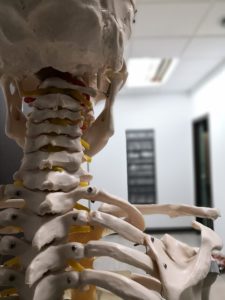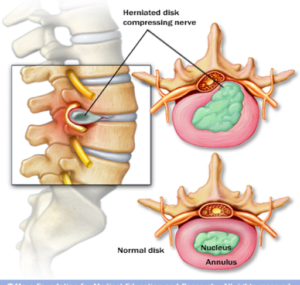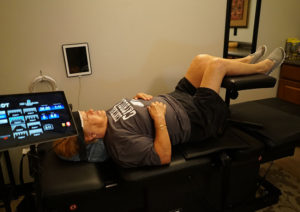Back and neck pain are common problems that can have many different causes. People often experience prolonged pain after an injury or as a result of repetitive use or unhealthy posture. If your pain is interfering with your life and you are looking for a non-invasive treatment, spinal decompression therapy may be right for you. This article will answer common questions about this innovative therapy so you can make an informed treatment choice.

What is Spinal Decompression Therapy?
Your spine is made up of small bones called vertebrae. Between each vertebra, there are cushy, fluid-filled structures called discs. Discs are often the source of chronic back pain. Normal wear and tear over time can cause the discs to flatten and harden. Some people don’t experience pain associated with this, but others develop a painful condition called degenerative disc disease. Injuries can shift discs, causing them to bulge out between vertebrae, or even rupture. Ruptured discs, sometimes called herniated discs, leak fluid that irritates surrounding tissues and causes pain.
Spinal decompression therapy is different from surgical spinal decompression. The latter involves metal spacers that are inserted to replace damaged discs. Spinal decompression therapy is a non-surgical, pain-free treatment that creates negative pressure between the vertebrae of the spine. It achieves this by gently stretching the spine. Discs that are bulging and compressed are pulled back into alignment, relieving pressure on nerves. Fluids and nutrients are also pulled in, re-hydrating compressed discs and encouraging healing.

What Kinds of Back Problems Can It Treat?
Spinal decompression therapy is especially helpful for problems involving herniated or degenerated discs. It can also help with spinal stenosis, facet syndrome, and sciatica pain. Back or neck pain that occurs after an accident or after lifting something wrong can sometimes be from an injured disc. Spinal decompression is often used as part of a treatment plan for accident victims. It can even help after failed back surgery. Talk to your chiropractor about the history of your back pain and tell him or her if you’ve had any surgeries. Not everyone who has had surgery will be a candidate for spinal decompression.

Does It Really Work?
Yes! Spinal decompression therapy is safe and effective for back and neck pain. Studies have found that spinal decompression leads to lasting pain relief for 86% of patients. This is because the treatment helps the body heal instead of temporarily masking the pain, as NSAIDs or injections do.

What Is the Treatment Like?
During a spinal decompression therapy session, the patient is secured to a special table while lying on their back. A computer is used to move the sections of the table slowly, in precise increments to stretch the spine. Most spinal decompression treatments last for about 30 minutes. Your technician will monitor the computer and use your input to adjust the settings. If you feel uncomfortable at any time, you can push the stop button or let the technician know. Most patients experience pain relief during the treatment because it relieves pressure on nerves.
Spinal decompression is sometimes confused with traction. The procedures both aim to create negative pressure in the spine, but they use different methods to achieve this. Traction is done manually, using ropes, slings, and pulleys to stretch the body. This method’s success is difficult to measure and can depend a lot on the person performing the procedure.
The mechanized method used during spinal decompression therapy is the only proven way to create negative pressures within the spine. One study found that traction was only successful in 55 % of patients, as opposed to a success rate of 86% in spinal decompression patients.
Who Should Not Have Spinal Decompression Therapy?
Spinal decompression is among the safest treatments for back pain. Like any procedure, it’s not appropriate for everyone. Pregnant women and people with certain types of tumors, fractures, or some other types of bone problems should not have spinal decompression. Talk to your doctor about your medical history, including any chronic health problems you may have and any recent surgeries.
People who have had a failed back surgery may be candidates for decompression if the surgery happened at least six months prior and if they do not have hardware implants or a fusion. The best way to know if you are a candidate is to talk to your chiropractor.
Some people have mild side effects, such as muscle pain or spasms after the first few treatments. This is because your muscles are being stretched in a new way, similar to when you begin a new workout routine. Let your chiropractor know if you experience this, and he or she can recommend home care that will make you more comfortable.

How Long Does it Take to See Results?
Most patients will require a series of 20-24 treatments over the course of several weeks to achieve lasting improvement. You can expect to feel some relief after the first few treatments and to gradually feel improvement as the series continues. Disc problems and other spinal issues often develop over a long period of time, and it can take several weeks to heal that damage.
Depending on what caused your back pain, your chiropractor may recommend other treatments along with spinal decompression therapy. These might include chiropractic adjustment or posture rehabilitation.
Our chiropractors in Murfreesboro have years of experience using spinal decompression therapy to treat back pain. We can set up a personalized treatment plan that will relieve your pain and improve your quality of life.


